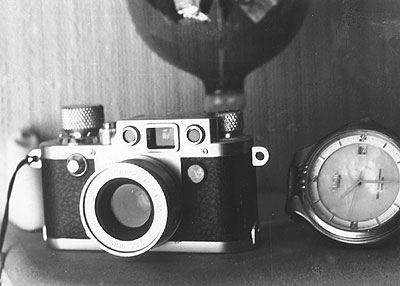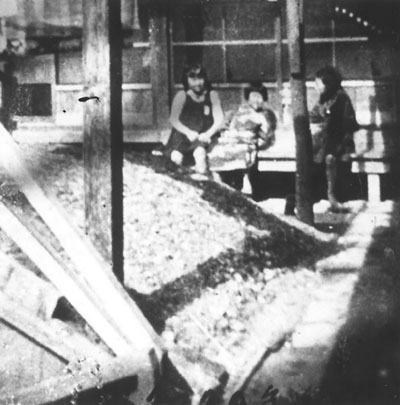November 27
A minor planet was named after Mr. Hiroshi Kanai, who is
the former president of Minox Club and miniature camera enthusiast. (Refer
to the list of the minor planets discovered by Seki.) Mr. Kanai is a photographer
born in 1915 in Tokyo and an expert on Minox cameras. "Minox"
itself is a minor planet (6995) now. For many years he has photographed
mostly with Minox cameras and created numerous masterpieces. He is already
over 90, but still actively pursuing his interest in photography.
I met him at a photographic session in Kyoto this May. I
was fortunate enough to have an opportunity to talk with him as both of
us were staying at the same hotel. My association with miniature cameras
started when I saw a midget camera in a classmate's good-looking red wallet.
I was an elementary school pupil in pre-war Japan.

A miniature camera called Sharan reminiscent of an old midget camera.
I used to take 12 exposures using 18 millimeter-wide film
backed with paper lining. The camera had only two shutter settings, 1/25
and B, with fixed focus and set aperture stops, but the results were reasonably
good. Around that time I became mad about miniature cameras, but it was
very difficult to get hold of cameras and films as it was on the eve of
the Pacific War. I was impressed with a scene in a film titled "Anatawa
Nerawareteiru" (or you are marked) where the main character was trying
hard to obtain film for his spy camera. Wanting to buy a miniature camera,
I was looking around the black market in the rundown area of the city.
I found a Guzzi camera beside old military boots. I got the camera by begging
my mother. I was never happier in my life. So excited, I took photos of
my mother and classmates one after another. While doing this, I inadvertently
took very precious photos. On the school excursion to Kyoto I photographed
Omi-ya before it was dismantled. Omi-ya was the soy-sauce store where Ryoma
Sakamoto was ambushed. With the breakout of the war, it became much harder
to get films, but I managed to take a photo of the bomb shelter dug in
our courtyard. This photo is the only record I have to tell the miseries
of the war.

A bomb shelter built in the spring of 1945 in our courtyard
Right over this bomb shelter I built an observing platform
after the war. This was exactly where we were watching enemy planes in
fear. Also, this was where I searched for comets and discovered them in
peacetime. Miniature cameras in my possession are my personal history itself.
I have a fond memory that I was mistaken for a spy and had my camera confiscated
by the special police, while taking a bird's-eye view of Kochi city from
an elevated place. In those days it was prohibited to photograph a view
of the city from a higher ground, even if you were not a spy.
November 11
Minor Planet Murikabushi was born
Minor planet Murikabushi was born. The minor planet 13989
was discovered at Geisei on January 16, 1993. The name Murikabushi was
proposed and the Minor Planet Center of IAU (International Astronomical
Union) has recently approved it. Murikabushi means a "swarm of stars"
in an Okinawan dialect and the recently completed 105cm reflector at Ishigakijima
Astronomical Observatory in Okinawa Prefecture is nicknamed Murikabushi.
Ishigakijima Astronomical Observatory is run by the National
Astronomical Observatory and also supported by the private sector. This
sort of cooperation between the government and private sector is the first
in Japan. Inspired by this unique and pleasing aspect of the observatory,
I had proposed "Murikabushi" for a minor planet I had discovered.
As the symbol of Ishigakijim Astronomical Observatory, it will shine forever
in the sky over the observatory. As long as this star of Murikabushi shines,
the observatory will live forever.
I hope that Murikabushi telescope captures this star shining
over Okinawa and it gives hopes to the people of Ishigakijima who love
this observatory. I haven't been to Okinawa yet, but someday I would like
to visit Ishigakijima myself.


